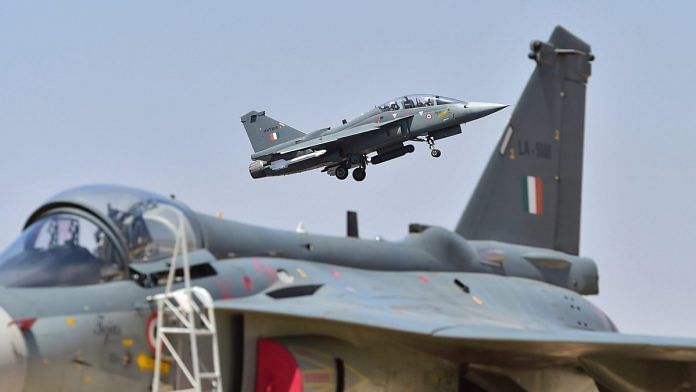New Delhi: On Wednesday, the Narendra Modi government cleared the Rs 48,000-crore deal for 83 LCA (Light Combat Aircraft) Tejas aircraft, which will see a greater collaboration between state-owned Hindustan Aeronautics Limited (HAL) and private firms as part of ‘Make in India’.
Of these 83 aircraft, HAL will deliver 73 Tejas Mk 1A and 10 Tejas Mk 1 trainers by 2026. Tejas will only be the second indigenously built fighter aircraft in India’s history.
In episode 661 of ‘Cut The Clutter’, ThePrint’s Editor-in-Chief Shekhar Gupta talked about the Tejas aircraft along with India’s adventures and misadventures with indigenous fighter aircraft.
Also read: Indian firm bags Army’s Rs 140-crore deal for high altitude UAVs, eyes exports too
Tejas’ history
According to Gupta, “1983 was the first time when the Government of India cleared a project to build a new Light Combat Aircraft as a replacement for MiG 21s.”
The first prototype of Tejas flew in 2001, 18 years after the project started.
In the 1970s and 80s, especially after the 1974 Pokhran nuclear tests, India was caught in a terrible environment of technology denial. The West, particularly America, denied India access to any ‘sensitive technology’, he noted.
While India’s strengths included the inherent ability in composite materials, design, math, and metallurgy, India lacked the know-how when it came to complex electronics, especially the engine. India’s project to build the engine ‘Kaveri’ for a Light Combat Aircraft failed, added Gupta.
With time, the “technology apartheid” ended and this helped India put together a complex fighter aircraft. Today, Tejas is 50 per cent indigenous. It has a GE American engine, an Israeli Elta radar, and British aerospace, avionics, and other engines.
The first prototype of Tejas flew in 2001. In December 2013, the first stages got Initial Operational Clearance. In 2019, the IAF was given the first aircraft with Final Operational Clearance.
The Indian Airforce is currently in possession of 20 Tejas Mk1 aircraft, which have got the Initial Operational Clearance. Some have got Final Operational clearance but the IAF hasn’t yet disclosed those figures yet.
By the time Tejas Mark1A becomes operational, Gupta said, IAF will have about three squadrons of Tejas Mk1 aircraft and will replace the really obsolete or ‘number plated’ squadrons.
Also read: Ladakh face-off has become Mexican standoff. LAC could heat up in summer
India’s misadventures with fighter aircraft
India has also had a chequered history with fighter aircraft in general.
By the mid-1950s, as India’s relationship with Pakistan was tanking, Nehru sought advanced technologies to fight the Pakistanis. India employed Dr Kurt Tank, a leading German aeronautical engineer who built the Luftwaffe aircraft in World War II. This aircraft was copied 20,000 times during the war.
In India, Tank was made the director of Madras Institute of Technology. He and his team built HAL HF-24 Marut, an indigenously built fighter-bomber aircraft.
Marut was supposed to be of supersonic speed but could never surpass the speed of sound. This, Gupta said, is largely because of the ‘technology denial’ era. Nobody would sell India a decent engine.
India then started fitting two Orpheus engines into one Marut. So the aircraft had two subsonic engines and always remained underpowered. As many as 147 Maruts were produced and they played an essential ground support role in the 1971 war with Pakistan.
By 1975, however, this programme was suspended, and the Maruts were sold for scraps.
Gupta also cited another example of “jugaad” that the Indian Air Force had to endure. This was the Canada-made Fairchild Packet Aircraft that could go to high altitudes and land at very short landing grounds. However, this was found to be inadequate for higher Himalayas.
So the Indian Airforce put a jetpack, which was an Orpheus engine, on the aircraft’s two piston engines to allow flying at higher altitudes.
Watch the latest episode of CTC here:




Why is the cut the clutter being removed from youtube?
If the Tejas uses a General Electric engine, it gets my guarded vote.
If we can be so successful in space technology, which needs expertise in so many different fields, why have we not been equally successful in technologies to build various defense requirements?
The obvious reason is it was not allowed and encouraged, even today we are not out of that mind set when we continue to quote chequered history of indigenization. Remind it we must but push for it as well.
All this happened because it was possible to buy that with hefty commissions unlike the space and nuclear technology . That reminder is more important than the chequered history of indigenization
How come since 2014 the DRDO and Indian private sector has suddenly become active? So many new products and almost a daily test of new missiles, they were not developed over-night, but just not allowed to surface because of the entrenched vested interests.
It is a well researched presentation both here and on the Youtube. Can you explain why India is unable to come up with rapid design and development of combat aircrafts, when in the West, even private companies seem to have the capability to manufacture combat aircrafts, and they do so quite rapidly. They don’t take 38 years to develop one combat aircraft. Apart from the problem of technology denial, there must be scores of problems prevailing in HAL, NAL, Aeronautica Development Agency, Gas Turbine Research Institute, IAF, not to speak of Aeronautics Departments in dozen IITs and IISC in Bengaluru.